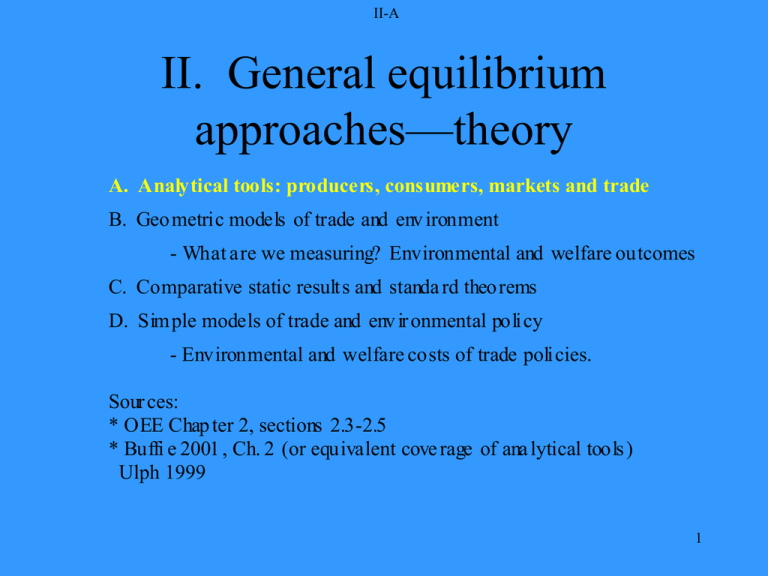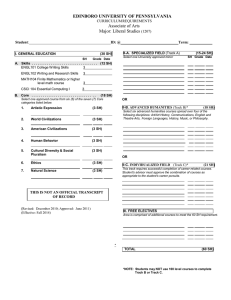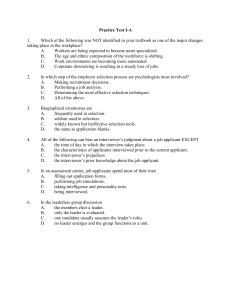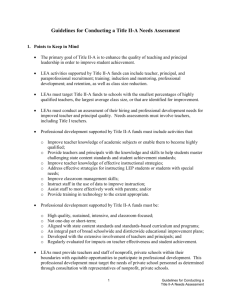II A. Basic concepts: functions and duality.
advertisement

II-A
II. General equilibrium
approaches—theory
A. Analytical tools: producers, consumers, markets and trade
B. Geo metric models of trade and env ironment
- What are we measuring? Environmental and welfare outcomes
C. Comparative static result s and standa rd theo rems
D. Sim ple models of trade and env ir onmental poli cy
- Environmental and welfare costs of trade poli cies.
Sour ces:
* OEE Chap ter 2, sections 2.3-2.5
* Buffi e 2001 , Ch. 2 (or equivalent cove rage of ana lytical tools )
Ulph 1999
1
II-A
A. Analytical tools
•
•
•
•
•
Producer’s problem
Consumer’s problem
Aggregate income and expenditure
Markets and trade
Distortions and non-traded goods
2
II-A
Producer’s problem
Maximiz e profits subject to resource endow ments v and techno logy.
Factor supplies are ‘fixed’ at the agg rega te leve l,
but can be all ocated across sectors producing the n goods.
Revenue ma ximi zation:
r(p, v) = maxy{py | (v,y feasible) }
= py*(p, v)
= Find revenue -maximi zing ou tput bund le, on su rface of PPF,
tangen tial t o price ratio.
3
II-A
Properties of r(p,v):
•
•
•
•
Inc reasing in p
Inc reasing in v
Homogeneous of degree 1 in p
Convex in p.
• If r() is twice differentiable then by enve lope theor em:
Žr/Žp = rp(p, v) = y(p, v)
(output vec tor)
Žr/Žv = rv(p, v) = w(p, v)
(shadow factor price vec tor).
and
4
II-A
Consumer’s problem
Maximiz e utilit y subject to a budg et constraint.
Can represent the consu mer's decision by a cost (expend it ure)
mi nimization p roblem
e(p, u) = mi nc{pc | u(c) •u}
= pc(p, u),
whe re c(p, u) is a vec tor of Hicksian (i.e. compensa ted) demand func tions .
Consumer will minimi ze exp. associated wit h a chieving target utilit y,
given initi al i nco me based on endo wments.
5
II-A
Properties of e(p,u): • Inc reasing in p
• Homogeneous of degree 1 in p
• Concave in p.
• If e() is twice differentiable then by enve lope theor em:
Že/Žp = ep(p, u) = c(p, u)
(cond iti ona l demand s for good s)
and
Že/Žu = money cost of an additional un it of utilit y, i.e. reciprocal
of marginal utilit y o f income.
NB Conditional expend it ure func tion: when some quan titi es (such as
poll ution) are pub li c goods (or bads), i. e. their quan titi es are exogenous
to consu mers.
6
II-A
Aggregate budget constraint
Consumer's budge t constraint is same pric e li ne faced by produce rs.
Ther efore, total income of produce rs equa ls total expend it ure by
consumers.
In equ ili brium,
r(p, v) = e(p, u)
Total inco me from produc tion is equa l to total expend it ure by consumers.
7
II-A
Equilibrium: Walras’ law
When agg rega te inco me and expend it ure are equa l, trade is also in ba lance
-- Define excess demand for each good as cj – yj = mj (ne t im ports)
-- Notice that mj > (<) 0 deno tes im port (expor t)).
-- Then if consumers on budge t cons traint, the sum o f all exce ss dds is
equa l t o zero, including exce ss dd for foreign cu rrency to buy im ports.
Setting e(p, u) = r(p, v), and subs tit uting:
j
pjcj j pjyj
p j j c j yj j p j mj 0
So in equili brium, wit h consu mers on budge t cons traints and firm s
maximi zing p rofits (i.e. on PPF), trade is also in balanc e, by Walr as' Law.
8
II-A
Equilibrium of a two-sector
economy
y2
p = p2/p1
y = (y1, y2)
m2
c = (c1, c2)
u
m1
y1
9
II-A
Trade expendi ture function
For the mod el just described, the agg rega te budge t cons traint,
e(p, u) = r(p, v)
contains all the information nece ssary to describe an equ ili brium.
We can a lso use it for comparative static ana lysis of the effects
of price, endow ment and techno logy shocks .
10
II-A
Trade policy distortions
•
E.g. trade policy.
•
•
•
Define tariff-distorted prices p* = p(1 + t).
TEF is now:
e(p*, u) = r(p*, v) + t•m
11
II-A
Externalities
•
E.g. env. externality in production
•
•
•
•
TEF is now:
e(p, u) = r(p, v) - z'y
where z is qty of pollution per unit of y
produced.
Env. externality in consumption:
u = u(c, z) ==> e(p, z, u)
•
NB assumption of separability.
12
II-A
Non-traded goods
•
Goods may be non-traded (or effectively so) for
intrinsic and policy reasons.
If one good is non-traded, for this, mn = 0.
•
•
•
•
•
•
Equilibrium now requires additional equation:
e(p, u) = r(p, v)
en(p, u) = rn(p, v)
and solves for pn as well as agg. welfare.
With endog. prices, preferences play a role.
13
II-A
Salter-Swann diagram
T
RER = pN/pT
(yT, yN) = (cT, cN)
N
14
II-A
Effects of growth
T
N
15
II-A
Equilibrium: macro view
(A) Base model
Y = C + I + G + (X - M)
let C + I + G = E be agg. dom. spending; so
Y - E = X - M in equilibrium. Internal balance <==>
external balance
(B) With taxes and int’l capital flows
Y + R - T = C + I + G - T + (X + R - M)
let Y + R - T - C = S be agg. dom. savings; so
X + R - M = (S - I) + (T - G) in eq’m. Curr. acc.
surplus is equal to excess of savings over
investment plus gov’t budget surplus.
16
II-A
Summary
• Basic tools reflect our assumptions about
technology, preferences and behavior
• Representative agent models
• Focus of trade as determinant of price
formation
• Aggregate budget constraints impose
internal consistency
• Many forms of complication are possible.
17
II-A
Q & A: basic tools
18





